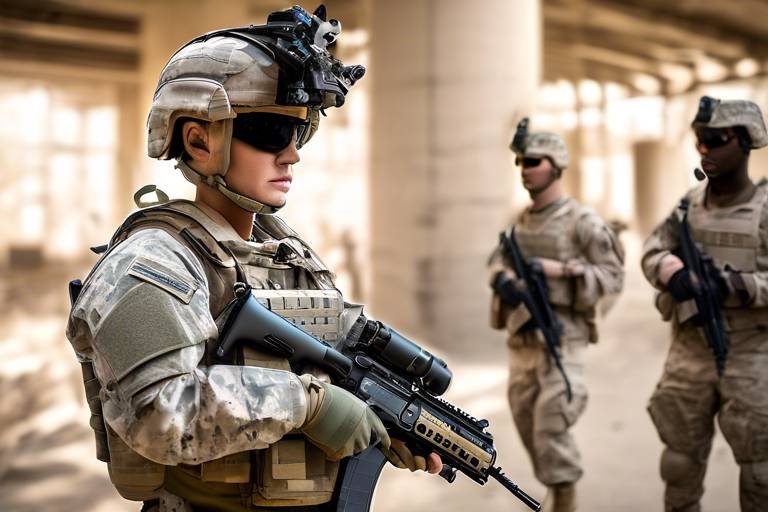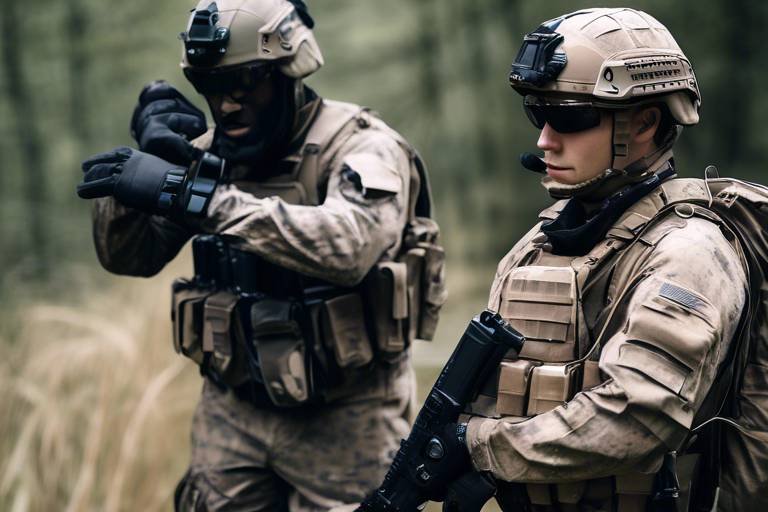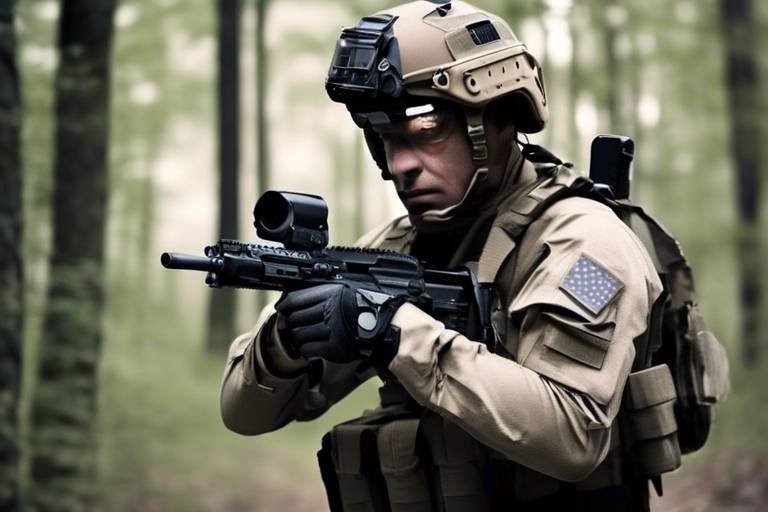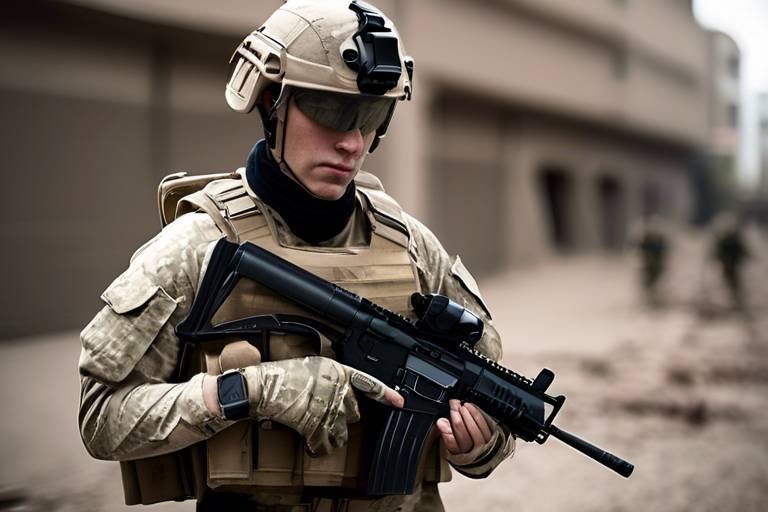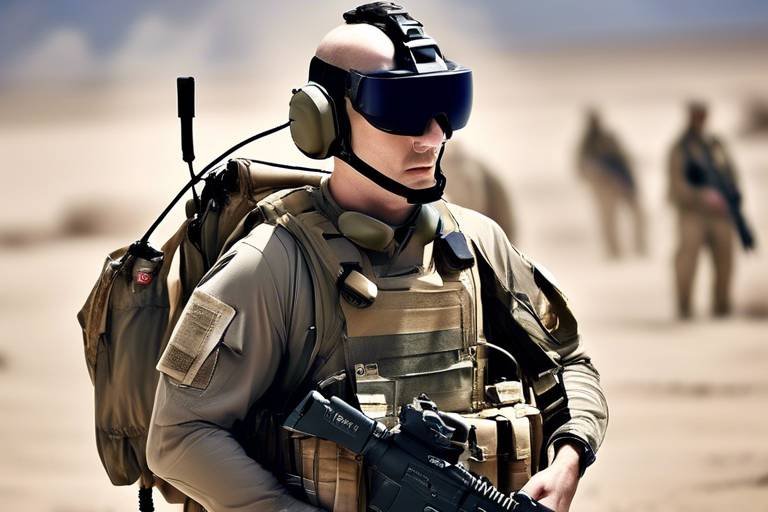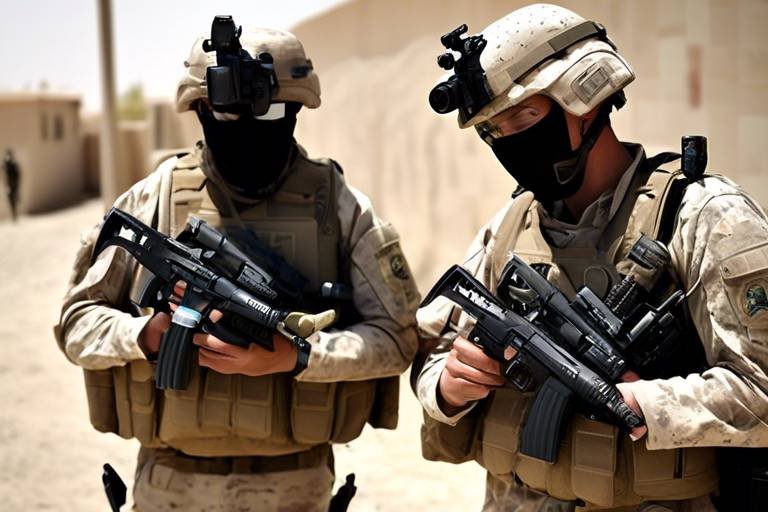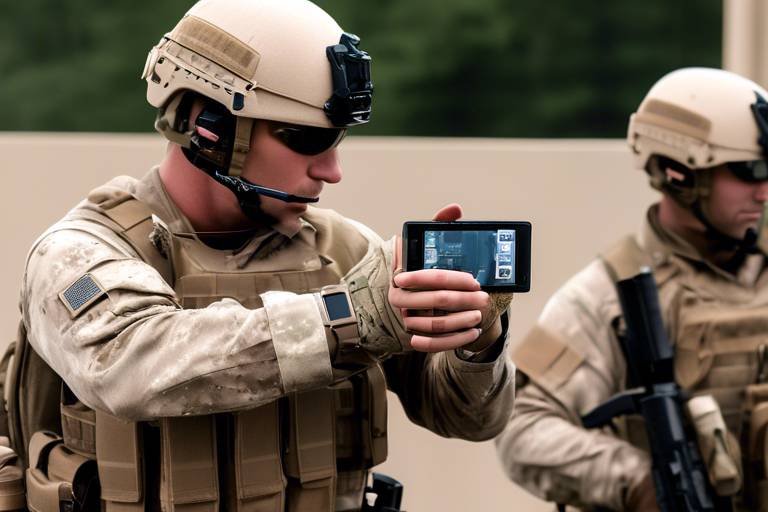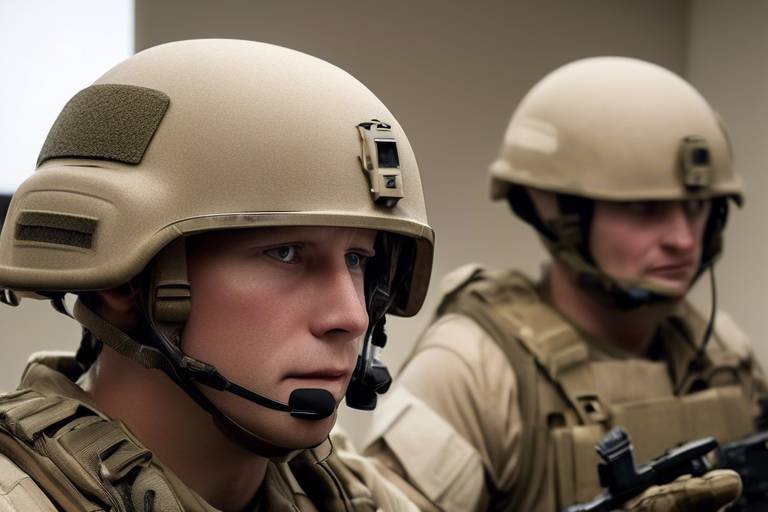Wearable Sensors for Tracking Heat Stress in Soldiers
In today's fast-paced military operations, heat stress poses a significant threat to soldiers' health and performance. As they navigate through extreme environments, the risk of heat-related illnesses increases, making it essential to monitor their physiological conditions effectively. This is where wearable sensors come into play. These innovative devices are designed to track various physiological metrics, providing real-time data that can be crucial for maintaining soldier safety and enhancing operational effectiveness.
Imagine a soldier on the battlefield, pushing their limits under the scorching sun. Without the right tools, their body could be silently succumbing to heat stress, leading to fatigue, heat exhaustion, or even heat stroke. Wearable sensors act like a vigilant guardian, continuously monitoring vital signs such as body temperature and heart rate. By doing so, they empower military personnel and commanders with the knowledge needed to make informed decisions about health and safety.
Furthermore, the integration of these sensors into military gear not only enhances individual soldier safety but also contributes to the overall success of missions. By providing insights into each soldier's physical state, commanders can adjust strategies, allocate resources more effectively, and ensure that their troops are operating at peak performance. The ability to detect heat stress early can be the difference between a successful mission and a tragic outcome.
As we delve deeper into the world of wearable sensors, we will explore their types, functionalities, and the critical role they play in monitoring heat stress. From body temperature sensors to heart rate monitors, each device offers unique advantages that, when combined, create a comprehensive monitoring system. This article will illuminate the importance of these technologies in safeguarding our soldiers and enhancing their operational readiness.
Understanding the significance of heat stress monitoring is crucial for soldier safety. Heat stress occurs when the body cannot cool itself effectively, leading to a rise in core temperature. This physiological response can impair cognitive functions, reduce physical performance, and, in severe cases, result in life-threatening conditions. Therefore, effective monitoring systems are essential in military operations, especially in hot climates.
Various wearable sensors are available for tracking heat stress. These devices range from simple temperature sensors to complex multi-sensor systems. Each type of sensor plays a vital role in monitoring soldiers' physiological conditions and ensuring their well-being during missions. Understanding the functionalities of these sensors can help military personnel choose the right tools for their specific needs.
Body temperature sensors are vital for detecting heat stress. These devices measure the core temperature of soldiers, providing real-time data that can indicate when a soldier is at risk of heat-related illnesses. By continuously monitoring temperature, these sensors help in making timely interventions, ensuring that soldiers remain safe and effective in the field.
There are different types of body temperature sensors used in the field, including:
- Ingestible Sensors: These sensors are swallowed and provide internal body temperature readings. They are highly accurate but may not be suitable for all soldiers due to discomfort.
- Wearable Patches: These are adhesive patches placed on the skin, offering a non-invasive way to monitor temperature. They are easy to use but may be less accurate in extreme conditions.
- Smart Clothing: Integrated into uniforms, these sensors provide continuous monitoring without the need for additional devices. However, they can be costly and require maintenance.
Integrating body temperature sensors with other monitoring devices enhances data accuracy. For instance, when combined with heart rate monitors and hydration sensors, the data collected provides a comprehensive view of a soldier's heat stress levels. This multi-sensor integration allows for better decision-making and timely interventions, ultimately improving soldier safety and mission success.
Heart rate monitoring plays a crucial role in assessing heat stress. An elevated heart rate can indicate physiological strain, signaling the need for immediate action. By tracking heart rate alongside body temperature, military personnel can gain valuable insights into a soldier's overall condition and make necessary adjustments to prevent heat-related issues.
Analyzing data collected from wearable sensors is essential for effective heat stress management. The integration of advanced analytics allows military personnel to interpret sensor data accurately, leading to informed decisions regarding soldier safety. With the right tools, commanders can identify trends, assess risks, and implement strategies to mitigate heat stress effectively.
Real-time data processing is crucial in heat stress situations. Technologies such as cloud computing and machine learning enable the rapid processing of sensor data, allowing for immediate action when a soldier's condition deteriorates. This capability is vital in military operations, where every second counts.
Long-term health monitoring through wearable sensors can enhance soldier resilience. Continuous monitoring provides insights into individual health trends, helping to identify potential issues before they become critical. This proactive approach not only improves soldier well-being but also contributes to overall mission readiness.
Despite their advantages, wearable sensors face challenges. Environmental factors such as extreme weather conditions can affect sensor performance, leading to inaccuracies in data collection. Additionally, user compliance is vital for successful sensor implementation. Soldiers must accept and trust these technologies for them to be effective.
Environmental factors can significantly impact sensor performance. For instance, high humidity or extreme temperatures may cause sensors to malfunction or provide inaccurate readings. Understanding these limitations is crucial for military personnel to make informed decisions based on the data collected.
User compliance is vital for successful sensor implementation. Soldiers must feel comfortable using wearable technology, and their willingness to adopt these devices can be influenced by factors such as ease of use, perceived benefits, and overall trust in the technology. Addressing these concerns is essential for maximizing the effectiveness of wearable sensors in the field.
Q: How do wearable sensors help prevent heat stress in soldiers?
A: Wearable sensors continuously monitor vital signs such as body temperature and heart rate, allowing for early detection of heat stress and timely interventions.
Q: What types of wearable sensors are available for military use?
A: Common types include ingestible sensors, wearable patches, and smart clothing, each offering unique advantages and limitations.
Q: Can wearable sensors be integrated with other monitoring devices?
A: Yes, integrating body temperature sensors with heart rate monitors and hydration sensors provides a comprehensive view of a soldier's health.
Q: What challenges do wearable sensors face in military environments?
A: Environmental factors, user compliance, and acceptance are significant challenges that can affect the performance and effectiveness of wearable sensors.
Importance of Heat Stress Monitoring
Heat stress monitoring is not just a technical necessity; it is a critical component of ensuring the safety and effectiveness of soldiers in the field. Imagine being in a scorching desert or a humid jungle, where every step you take can lead to overheating. The physiological impacts of heat stress can be severe, leading to conditions such as heat exhaustion or heat stroke, which can be life-threatening. These conditions not only jeopardize the health of soldiers but can also compromise mission success, making it essential to have effective monitoring systems in place.
When soldiers are exposed to extreme temperatures, their bodies undergo various physiological changes. For instance, as the body tries to cool itself, heart rates can increase, and sweat production ramps up. If these changes go unchecked, it can lead to serious health issues. This is why understanding the significance of monitoring heat stress is paramount. By keeping track of vital signs and environmental conditions, military personnel can make informed decisions to prevent heat-related illnesses.
Furthermore, the need for effective monitoring systems extends beyond immediate safety. It also plays a crucial role in enhancing overall performance. When soldiers are aware of their heat stress levels, they can adjust their activities accordingly, ensuring they remain at peak performance. This proactive approach not only safeguards their health but also contributes to the success of their missions. In essence, heat stress monitoring is a lifeline that empowers soldiers to operate effectively under extreme conditions.
To illustrate the importance of heat stress monitoring, consider the following table that highlights the physiological impacts of heat stress:
| Physiological Impact | Description |
|---|---|
| Increased Heart Rate | As the body heats up, the heart pumps faster to circulate blood and dissipate heat. |
| Dehydration | Excessive sweating can lead to dehydration, affecting physical and cognitive performance. |
| Heat Exhaustion | A serious condition characterized by heavy sweating, weakness, and confusion. |
| Heat Stroke | A life-threatening condition where the body temperature rises to dangerous levels, leading to organ failure. |
In summary, heat stress monitoring is critical not just for the immediate safety of soldiers but also for maintaining their operational effectiveness. By implementing robust monitoring systems, we can ensure that our military personnel are prepared to face the challenges posed by extreme environments.
Types of Wearable Sensors
When it comes to monitoring heat stress in soldiers, the **variety of wearable sensors** available today is nothing short of astounding. These sensors are designed to provide real-time feedback on physiological conditions, allowing for timely interventions that can make a significant difference in a soldier's performance and safety. Each type of sensor has its own unique functionalities, catering to different aspects of health monitoring. Understanding these options is crucial for military operations, especially in extreme environments where heat stress can be a serious threat.
One of the primary types of wearable sensors used in tracking heat stress is the **body temperature sensor**. These sensors are essential for detecting even slight increases in body temperature, which can be an early warning sign of heat-related illnesses. They operate using various technologies, including thermistors and infrared sensors, to provide accurate readings. The importance of these sensors cannot be overstated, as they allow commanders to make informed decisions about when to take action to protect their troops.
Body temperature sensors come in several forms, each with its own set of advantages and disadvantages. For example, **thermocouples** are known for their accuracy but can be cumbersome to wear. On the other hand, **infrared sensors** offer a non-invasive method to monitor temperature but may be less reliable in extreme conditions. Here’s a quick comparison of some common types:
| Sensor Type | Advantages | Disadvantages |
|---|---|---|
| Thermocouples | High accuracy | May be uncomfortable to wear |
| Infrared Sensors | Non-invasive | Less reliable in extreme conditions |
| Wearable Patches | Comfortable and easy to use | Potential for sensor drift over time |
Moreover, the integration of body temperature sensors with other types of sensors, such as **heart rate monitors** and **humidity sensors**, can significantly enhance the accuracy of the data collected. This multi-sensor integration provides a more comprehensive view of a soldier's physiological status, allowing for better decision-making in high-pressure situations. Imagine trying to navigate a maze blindfolded; having multiple sources of information can help you find your way out much faster and more efficiently.
In addition to body temperature sensors, **heart rate monitors** play a crucial role in assessing heat stress. By tracking heart rate variability, these devices can indicate physiological strain and alert commanders to potential issues. The data from heart rate monitors can be particularly telling; for instance, an elevated heart rate combined with high body temperature can signal that a soldier is at risk of heat exhaustion.
Ultimately, the types of wearable sensors available today are not just gadgets; they are lifesaving tools that enhance the operational effectiveness of military personnel. As technology continues to evolve, we can expect even more sophisticated sensors to emerge, providing soldiers with the critical data they need to stay safe and perform at their best in the field.
Body Temperature Sensors
Body temperature sensors are essential tools in the arsenal for monitoring heat stress among soldiers. These sensors act as vigilant guardians, constantly tracking the internal temperature of the body, which is crucial in preventing heat-related illnesses during intense physical exertion in extreme conditions. Imagine being out in the blistering heat, your body working hard as you march through the terrain; without these sensors, you might not realize you're overheating until it's too late. That's where the magic of technology steps in, offering a lifeline to our brave soldiers.
These sensors operate on various principles, utilizing advanced technology to provide real-time data that can be critical for immediate intervention. For instance, some body temperature sensors use thermoelectric technology, which allows them to measure temperature changes quickly and accurately. Others might employ infrared technology, capturing heat emitted from the body without direct contact. Regardless of the method, the goal remains the same: to keep soldiers safe and operational.
One of the standout features of body temperature sensors is their ability to integrate seamlessly with other monitoring devices. This integration enhances the overall accuracy of the data collected, providing a comprehensive view of a soldier's physiological state. By combining temperature readings with other metrics, such as heart rate and humidity levels, commanders can make informed decisions that significantly impact mission success and soldier safety.
To illustrate the importance of body temperature sensors, consider the following table that outlines the different types of body temperature sensors used in military applications:
| Type of Sensor | Advantages | Disadvantages |
|---|---|---|
| Thermocouples | High accuracy, quick response time | Requires physical contact, can be invasive |
| Infrared Sensors | Non-invasive, easy to use | Can be affected by environmental conditions |
| Wearable Patches | Comfortable, continuous monitoring | Battery life limitations, potential for skin irritation |
Each type of sensor has its unique strengths and weaknesses, making it crucial for military personnel to choose the right one based on the mission's specific requirements. The advancements in body temperature sensor technology are not just about keeping soldiers safe; they also enhance overall performance. By having real-time data at their fingertips, soldiers can adjust their efforts, hydrate, or seek shade before reaching a critical heat stress level.
In summary, body temperature sensors are a pivotal component in the fight against heat stress in military operations. They provide invaluable insights that allow for proactive measures, ensuring that our soldiers remain healthy and capable of performing their duties effectively, even in the harshest conditions. As technology continues to evolve, we can expect these sensors to become even more sophisticated, offering enhanced features that further protect our brave men and women in uniform.
Types of Body Temperature Sensors
When it comes to monitoring heat stress in soldiers, body temperature sensors are at the forefront of technology. These sensors are designed to provide real-time data on a soldier's body temperature, which is crucial for preventing heat-related illnesses during intense military operations. There are several types of body temperature sensors available, each with its own unique advantages and potential drawbacks. Let's dive into the most common types:
- Ingestible Sensors: These sensors are swallowed and can provide continuous internal temperature readings. They offer a highly accurate measurement of core body temperature, which is essential for assessing heat stress. However, the idea of ingesting a device can be daunting for some soldiers.
- Wearable Patches: These adhesive patches are placed on the skin and can monitor temperature through sweat and skin temperature changes. They are non-invasive and easy to use, making them a popular choice among soldiers. However, their accuracy can be affected by external factors such as humidity and sweat.
- Smart Clothing: Integrating sensors into uniforms, smart clothing can monitor body temperature while providing the added benefit of comfort and mobility. This technology is still evolving, and while it has great potential, the initial costs and durability in harsh environments can be concerns.
- Thermal Imaging Sensors: These sensors use infrared technology to measure skin temperature from a distance. While they can provide quick assessments without physical contact, they may not be as effective in accurately reflecting core body temperature changes.
Each type of body temperature sensor serves a specific purpose and has its own set of strengths and weaknesses. For example, while ingestible sensors provide the most accurate core body temperature readings, they may not be suitable for all soldiers due to personal comfort levels. On the other hand, wearable patches and smart clothing offer ease of use but may face challenges in terms of accuracy under extreme conditions.
Ultimately, the choice of sensor depends on the specific needs of the mission and the soldiers involved. The integration of these sensors into a comprehensive monitoring system can enhance the safety and performance of soldiers in high-stress environments, allowing for timely interventions when heat stress is detected.
Integration with Other Sensors
Integrating body temperature sensors with other wearable devices is a game-changer in the realm of heat stress monitoring for soldiers. Imagine a symphony where each instrument plays its part, creating a harmonious blend of data that paints a complete picture of a soldier's physiological state. This integration not only enhances the accuracy of the data collected but also provides a more comprehensive view of how a soldier is coping with extreme heat. By combining multiple sensors, such as heart rate monitors, hydration sensors, and environmental sensors, we can gather a wealth of information that helps in making informed decisions in real-time.
For instance, when body temperature data is cross-referenced with heart rate information, it can indicate whether a soldier is experiencing heat stress or if they are merely exerting themselves physically. This dual data stream is crucial because it allows commanders to act swiftly and appropriately, potentially saving lives. Moreover, integrating environmental sensors can provide context to the physiological data. If a soldier's body temperature is rising while the environmental sensor indicates high humidity, it could signal an urgent need for cooling measures.
Furthermore, the integration of these sensors can be visualized effectively through a centralized dashboard. Such a system can display real-time data from multiple sources, allowing for a quick assessment of a soldier's health. This approach not only streamlines the monitoring process but also enhances situational awareness for commanders in the field. The table below illustrates the types of sensors that can be integrated and their respective roles:
| Sensor Type | Functionality |
|---|---|
| Body Temperature Sensor | Monitors core body temperature to detect heat stress. |
| Heart Rate Monitor | Tracks heart rate to assess cardiovascular strain. |
| Hydration Sensor | Measures hydration levels to prevent dehydration-related issues. |
| Environmental Sensor | Monitors external temperature, humidity, and other environmental factors. |
In conclusion, the integration of body temperature sensors with other wearable technologies is not just an enhancement; it’s a necessity in modern military operations. By leveraging the strengths of various sensors, we can ensure that soldiers are better protected from the dangers of heat stress, ultimately leading to improved mission success and soldier safety. As technology continues to evolve, the potential for even more sophisticated integrations only grows, promising a future where soldiers can operate in extreme conditions with greater confidence and safety.
- What are wearable sensors? Wearable sensors are devices that monitor various physiological parameters, such as body temperature and heart rate, to assess an individual's health status.
- How do body temperature sensors work? Body temperature sensors work by measuring the heat emitted from the body, providing real-time data that helps detect heat stress.
- Why is integration important? Integration is important because it allows for a comprehensive understanding of a soldier's physiological state, improving decision-making in critical situations.
- What challenges do wearable sensors face? Wearable sensors can face challenges such as environmental factors that affect accuracy and the need for user compliance among soldiers.
Heart Rate Monitoring
Heart rate monitoring is not just about keeping track of a soldier's pulse; it's a vital tool that provides profound insights into their physiological state during high-stress situations, particularly in extreme heat. When the temperature rises, so does the risk of heat-related illnesses, and understanding how the heart responds can be a game changer. Imagine being in a hot desert, carrying heavy gear, and your heart rate is climbing—this is where wearable technology becomes essential.
Wearable sensors that monitor heart rate can detect changes in a soldier's cardiovascular response, offering real-time data that is crucial for ensuring safety. For instance, a sudden spike in heart rate can indicate that a soldier is experiencing heat stress, prompting immediate action to cool down and hydrate. These sensors work by employing advanced optical technology, which measures the blood flow through the skin, providing an accurate reading of the heart rate without the need for cumbersome equipment.
Moreover, heart rate data can be incredibly informative when analyzed in conjunction with other physiological metrics such as body temperature and hydration levels. This multi-faceted approach allows military personnel to get a comprehensive view of a soldier’s condition. For example, if a soldier's heart rate is elevated but their body temperature remains stable, it might indicate anxiety or stress rather than heat illness. This nuanced understanding helps in making informed decisions, whether it's to continue the mission or take a break.
In addition to immediate monitoring, heart rate data can also contribute to long-term health assessments. By tracking heart rate trends over time, military health professionals can identify patterns that may indicate underlying health issues or vulnerabilities to heat stress. This continuous monitoring not only aids in immediate safety but also enhances the overall resilience of soldiers, ensuring they are fit for duty even in the harshest conditions.
To illustrate the importance of heart rate monitoring, consider the following table that summarizes the key benefits:
| Benefit | Description |
|---|---|
| Real-time Monitoring | Provides immediate data on a soldier's physiological state, allowing for quick interventions. |
| Data Integration | Combines heart rate data with other metrics for a comprehensive view of health. |
| Long-term Health Insights | Tracks trends over time to identify potential health risks and improve soldier resilience. |
In conclusion, heart rate monitoring is an indispensable component of heat stress management in military operations. By leveraging cutting-edge technology, we can ensure that our soldiers are not only safe but also performing at their best, even in the most challenging environments. As we continue to develop these technologies, the potential for enhancing soldier safety and mission success is immense.
- How do wearable heart rate monitors work? - They use optical sensors to detect blood flow through the skin, providing accurate heart rate readings.
- Can heart rate monitoring prevent heat-related illnesses? - Yes, by providing real-time data, it allows for timely interventions to prevent overheating.
- What other metrics can be monitored alongside heart rate? - Body temperature, hydration levels, and activity levels are commonly monitored together.
- Are these devices comfortable for soldiers to wear? - Most modern wearable sensors are designed to be lightweight and unobtrusive, ensuring comfort during operations.
Data Analysis and Interpretation
When it comes to heat stress management in military operations, the ability to analyze and interpret data collected from wearable sensors is nothing short of vital. These sensors generate a wealth of information, but without proper analysis, that data is just noise. Imagine trying to navigate a dense fog without a compass; that's what it feels like to have data without the means to interpret it. The key lies in transforming raw numbers into actionable insights that can enhance soldier safety and performance.
To effectively manage heat stress, military personnel rely on various data analysis techniques. These techniques can range from basic statistical analysis to more complex algorithms that leverage artificial intelligence. For instance, algorithms can analyze patterns in body temperature and heart rate data to predict when a soldier might be at risk of heat-related illnesses. By identifying these patterns, commanders can make informed decisions in real-time, ensuring that soldiers receive the care they need before a situation escalates.
Moreover, real-time data processing plays a crucial role in this analysis. With the advancement of technology, wearable sensors now have the capability to transmit data instantaneously. This means that as soon as a soldier's body temperature rises above a certain threshold, alerts can be sent out, prompting immediate action. Think of it as having a personal health assistant that never sleeps—always monitoring and ready to sound the alarm when necessary.
However, interpreting this data isn't just about numbers; it's about understanding the context in which the data was collected. For example, a soldier's heart rate may spike during a training exercise, but that doesn't necessarily indicate heat stress if they are exerting themselves. Therefore, data interpretation must consider external factors such as environmental conditions, the soldier's activity level, and even hydration status. This holistic approach ensures that the data is not only accurate but also relevant.
Another aspect of data analysis is the ability to provide long-term health monitoring. Continuous tracking allows for the accumulation of data over time, which can reveal trends and changes in a soldier's physiological responses to heat stress. For example, if a soldier consistently shows elevated heart rates during specific training exercises, this could indicate a need for adjustments in their training regimen or hydration strategies. Over time, this kind of analysis can help in building a more resilient fighting force.
In summary, the analysis and interpretation of data from wearable sensors are critical components of heat stress management in military settings. By employing advanced analytical techniques and considering the broader context of the data, military leaders can make informed decisions that not only enhance soldier safety but also improve overall mission success. The future of military operations lies in the ability to harness this data effectively, turning potential risks into manageable challenges.
- What types of data can wearable sensors collect?
Wearable sensors can collect various types of data, including body temperature, heart rate, humidity levels, and even hydration status. - How quickly can data be processed in real-time?
With modern technology, data can be processed in seconds, allowing for immediate alerts and interventions when needed. - Can data from wearable sensors be used for long-term health monitoring?
Yes, continuous monitoring can help identify trends and inform training adjustments to enhance soldier resilience. - What are the challenges in interpreting sensor data?
Challenges include accounting for external factors, ensuring data accuracy, and achieving soldier compliance with the technology.
Real-time Data Processing
In the fast-paced world of military operations, is not just a luxury; it's a necessity. Imagine being in the heat of battle, where every second counts, and the difference between life and death can hinge on immediate information. Wearable sensors designed to monitor heat stress in soldiers must be able to process data instantaneously to provide actionable insights. This capability allows commanders and medics to make informed decisions swiftly, ensuring the safety and effectiveness of their troops.
Real-time data processing involves several advanced technologies that work in harmony to analyze the data collected from various sensors. These technologies include edge computing, which allows data to be processed close to the source rather than being sent to a central server. This minimizes latency and ensures that critical information is available almost instantaneously. For instance, if a soldier's body temperature rises to dangerous levels, the system can trigger an alert within seconds, prompting immediate intervention.
Moreover, the integration of machine learning algorithms enhances the ability to predict heat stress incidents before they occur. By analyzing patterns in the data collected from previous missions, these algorithms can identify potential stressors and alert soldiers to take preventive measures. This proactive approach not only saves lives but also maintains operational efficiency. The use of cloud computing further supports this process by allowing for the aggregation of data from multiple sources, providing a comprehensive view of the battlefield conditions.
To illustrate the impact of real-time data processing, consider the following table that summarizes key benefits:
| Benefit | Description |
|---|---|
| Immediate Alerts | Enables instant notifications for critical physiological changes. |
| Enhanced Decision Making | Facilitates quick, informed decisions by commanders and medics. |
| Predictive Analytics | Utilizes historical data to forecast potential heat stress incidents. |
| Data Integration | Combines data from various sensors for a holistic view of soldier health. |
Real-time data processing not only enhances the immediate response to heat stress but also contributes to long-term soldier health management. By continuously monitoring physiological data, military health professionals can track trends over time, identifying soldiers who may be at risk for heat-related illnesses before they become critical. This proactive stance is akin to having a weather radar for storms; it allows the military to prepare and respond to potential crises before they escalate.
In conclusion, the ability to process data in real-time is a game-changer for military operations. As technology continues to evolve, the integration of real-time data processing with wearable sensors will undoubtedly enhance the safety, performance, and overall mission success of soldiers operating in extreme conditions.
- What are wearable sensors? Wearable sensors are devices that monitor physiological parameters, such as body temperature and heart rate, to assess health conditions.
- How do real-time data processing systems work? These systems analyze data from wearable sensors immediately, allowing for quick decision-making and alerts in critical situations.
- Why is heat stress monitoring important for soldiers? Monitoring heat stress is crucial to prevent heat-related illnesses, which can impair performance and jeopardize mission success.
- What technologies are used in real-time data processing? Technologies such as edge computing, machine learning, and cloud computing are utilized to enhance data processing capabilities.
Long-term Health Monitoring
Long-term health monitoring through wearable sensors is not just a trend; it's a revolutionary approach to enhancing soldier resilience and performance. Imagine being able to track your health metrics continuously, like having a personal health coach right on your wrist! These sensors provide real-time data that can lead to significant improvements in how soldiers manage their physical well-being over time. By continuously monitoring vital signs such as heart rate, body temperature, and hydration levels, military personnel can gain insights into their physiological status, allowing them to make informed decisions that can prevent heat-related illnesses and other health complications.
One of the primary benefits of long-term health monitoring is the early detection of potential health issues. Just like you wouldn't ignore a warning light on your car's dashboard, soldiers can benefit from being alerted to changes in their health metrics before they escalate into serious problems. For instance, if a soldier's body temperature consistently trends higher than normal, this could indicate an increased risk of heat stress, prompting timely interventions. This proactive approach not only enhances individual safety but also contributes to the overall effectiveness of military operations.
Moreover, the data collected from wearable sensors can be invaluable for long-term health studies. By analyzing trends over time, researchers can identify patterns that may lead to better training protocols and health strategies tailored specifically for soldiers. This could include adjustments in hydration strategies, rest periods, and even nutrition, ultimately leading to a more resilient force capable of performing at its best under extreme conditions.
However, it's important to note that the effectiveness of long-term health monitoring hinges on the reliability of the wearable technology used. Sensors must be accurate and durable enough to withstand the rigors of military environments. As technology advances, we can expect to see improvements in sensor design, making them more user-friendly and less intrusive. The integration of artificial intelligence and machine learning into data analysis will further enhance the ability to predict and respond to health risks, creating a smarter, more adaptive approach to soldier health management.
In summary, long-term health monitoring through wearable sensors is a game changer for military personnel. It fosters a culture of health awareness and preventive care, ultimately ensuring that soldiers are not only combat-ready but also physically prepared for the challenges they face. The ongoing evolution of this technology promises to enhance soldier safety, performance, and longevity in service.
- What types of data can wearable sensors track? Wearable sensors can track various health metrics, including heart rate, body temperature, hydration levels, and activity levels.
- How do wearable sensors help in preventing heat stress? By providing real-time data on physiological conditions, wearable sensors enable timely interventions to prevent heat-related illnesses.
- Are wearable sensors reliable in extreme environments? While many sensors are designed for durability, their performance can be affected by environmental factors. Continuous improvements in technology aim to enhance reliability.
- Can long-term monitoring improve overall soldier performance? Yes, by identifying health trends and potential issues early, long-term monitoring can lead to better health management and enhanced performance.
Challenges and Limitations
While wearable sensors are revolutionizing the way we monitor heat stress in soldiers, they are not without their . Understanding these hurdles is crucial for improving the technology and ensuring that it effectively serves our brave men and women in uniform. One of the primary challenges is related to the environmental factors that can significantly impact sensor performance. For instance, extreme temperatures, humidity levels, and even dust can interfere with the accuracy of the readings. Imagine running a marathon in the sweltering heat while trying to rely on a device that might be malfunctioning due to the very conditions you're facing! This scenario highlights the need for robust sensors that can withstand harsh environments.
Another challenge is user compliance and acceptance. Even the most advanced technology is only as good as its users. If soldiers are reluctant to wear these sensors, their effectiveness diminishes drastically. Factors influencing acceptance can range from concerns about comfort and practicality to a general skepticism about technology in the field. It’s essential to engage with soldiers during the development phase to address these concerns and ensure that the sensors are not only functional but also appealing to wear. After all, if a soldier feels like they are encumbered by their gear, they're less likely to wear it consistently.
Moreover, the data privacy and security issues surrounding wearable technology cannot be overlooked. With sensitive health data being collected, there is a pressing need to ensure that this information is protected from unauthorized access. Military organizations must invest in robust cybersecurity measures to safeguard the data of their personnel. This is especially critical in an age where cyber threats are evolving rapidly. If a soldier's health data were to fall into the wrong hands, it could pose serious risks not only to the individual but also to national security.
Finally, the cost of implementation can also be a significant barrier. Developing, testing, and deploying wearable sensors involves substantial financial investment. Military budgets are often tight, and allocating funds for new technology can be a tough sell. However, when considering the potential for saving lives and enhancing operational effectiveness, the long-term benefits may outweigh the initial costs. It’s about finding a balance between innovation and budgetary constraints.
In summary, while wearable sensors for tracking heat stress in soldiers offer incredible potential, it’s essential to address the challenges and limitations they face. By overcoming environmental factors, improving user acceptance, ensuring data security, and managing costs, we can enhance the effectiveness of these technologies and ultimately safeguard the health and performance of our soldiers.
- What are wearable sensors? Wearable sensors are devices that can be worn on the body to monitor various physiological parameters, including body temperature and heart rate.
- How do wearable sensors help in monitoring heat stress? They provide real-time data that helps identify when a soldier is at risk of heat-related illnesses, allowing for timely interventions.
- What challenges do wearable sensors face? They face challenges such as environmental factors, user compliance, data privacy, and cost of implementation.
- Why is user acceptance important? If soldiers do not feel comfortable or see the value in wearing sensors, they are less likely to use them, reducing their effectiveness.
- How can data privacy be ensured? Robust cybersecurity measures must be implemented to protect sensitive health data collected by wearable sensors.
Environmental Factors
When it comes to wearable sensors for tracking heat stress in soldiers, play a critical role that cannot be overlooked. Imagine being in the middle of a desert, with the sun beating down relentlessly, or navigating through a humid jungle where sweat drips continuously. These extreme conditions not only challenge the physical endurance of soldiers but also pose significant threats to the accuracy and reliability of the sensors they rely on. Different environmental factors can impact how these sensors function, leading to potential misinterpretations of data that could jeopardize a soldier's safety.
For instance, high temperatures can cause sensors to overheat, resulting in erroneous readings. Similarly, humidity can affect the sensor's ability to maintain a stable connection with the monitoring system. In some cases, moisture can infiltrate the device, leading to malfunctions that could go unnoticed until it’s too late. It's essential to understand how these environmental variables interact with wearable technology and what measures can be taken to mitigate their effects.
Here are some key environmental factors that influence the performance of wearable sensors:
- Temperature Extremes: Both high and low temperatures can affect sensor accuracy. Sensors may fail to provide accurate readings in extreme heat or cold, which can lead to dangerous situations.
- Humidity Levels: High humidity can cause sensors to malfunction or provide misleading data due to condensation.
- Altitude: Changes in altitude can affect physiological responses in soldiers, which wearable sensors must account for to provide accurate assessments.
- Physical Activity: The level of physical exertion can influence body temperature and heart rate, making it vital for sensors to be calibrated to account for varying activity levels.
To enhance the reliability of heat stress monitoring in diverse environments, it is crucial for developers to create sensors that are robust and adaptable. This involves rigorous testing under different conditions to ensure that the sensors can withstand harsh environments while providing accurate data. Furthermore, incorporating advanced materials and technologies can help improve the durability and performance of these devices.
In conclusion, understanding the impact of environmental factors on wearable sensors is essential for optimizing their use in military operations. By addressing these challenges, we can enhance the effectiveness of heat stress monitoring, ultimately contributing to the safety and performance of our soldiers in the field.
Q1: How do environmental factors affect the accuracy of wearable sensors?
A1: Environmental factors such as temperature extremes, humidity, and altitude can significantly impact the performance of wearable sensors, leading to inaccurate readings that could compromise soldier safety.
Q2: What measures can be taken to improve the reliability of wearable sensors in extreme conditions?
A2: Developers can enhance sensor reliability by using advanced materials, conducting rigorous testing in varied environments, and ensuring that sensors are calibrated for different physical activity levels.
Q3: Are there specific types of sensors better suited for harsh environments?
A3: Yes, certain sensors are designed with rugged features and materials that make them more resilient to extreme temperatures and humidity, thus providing more reliable data in challenging conditions.
User Compliance and Acceptance
User compliance and acceptance are critical factors that determine the success of wearable sensors in monitoring heat stress among soldiers. Imagine strapping on a high-tech device designed to keep you safe in extreme conditions, but if you don’t want to wear it, what’s the point? Soldiers need to feel comfortable and confident in the technology they’re using. The relationship between the user and the technology can make or break the effectiveness of these wearable sensors.
One of the primary reasons for resistance to new technology is the perception of discomfort. If a soldier feels that a sensor is bulky or interferes with their movement, they may choose not to wear it. Moreover, the psychological aspect of wearing a device that constantly monitors health can lead to anxiety. Soldiers are trained to be tough, and the idea of being monitored might feel like a vulnerability. Therefore, it’s essential for developers to focus on creating lightweight, unobtrusive designs that seamlessly integrate into a soldier’s gear.
Another important aspect is trust in the technology. Soldiers must believe that the data collected is accurate and that it can genuinely help them in life-threatening situations. If they perceive the sensors as unreliable, they may ignore the alerts or warnings provided by the technology. This trust can be built through rigorous testing and validation of the sensors in real-world scenarios, ensuring that soldiers see the tangible benefits of wearing them.
Additionally, education plays a vital role in user acceptance. Soldiers should be trained not just on how to use the wearable sensors, but also on understanding the importance of heat stress monitoring. When they grasp how these devices can enhance their safety and performance, they are more likely to embrace the technology. This can be achieved through engaging training sessions that highlight real-life examples of how heat stress management has saved lives.
Moreover, feedback loops are essential for improving user compliance. When soldiers feel that their opinions matter, they are more likely to use the devices. Implementing a system where soldiers can provide feedback on their experiences with the sensors can lead to continuous improvements. This can be done through surveys or focus groups, ensuring that the technology evolves based on user needs.
In summary, user compliance and acceptance are not just about the technology itself but also about how it is perceived and integrated into the soldier’s daily life. By focusing on comfort, trust, education, and feedback, the military can enhance the effectiveness of wearable sensors in tracking heat stress, ultimately leading to safer and more successful missions.
- What types of wearable sensors are used to track heat stress? Wearable sensors include body temperature sensors, heart rate monitors, and multi-sensor systems that integrate various physiological metrics.
- How do these sensors help in preventing heat-related illnesses? By providing real-time data on a soldier's physiological state, these sensors can alert them to dangerous conditions before they lead to serious health issues.
- Are there any challenges in using wearable sensors in the field? Yes, challenges include environmental factors that can affect sensor performance and the need for user compliance and acceptance.
- How can soldiers be encouraged to use wearable sensors? Through education about the benefits, ensuring comfort in design, and creating a feedback loop for improvements.
Frequently Asked Questions
- What is heat stress and why is it a concern for soldiers?
Heat stress occurs when the body cannot cool itself effectively, leading to overheating. For soldiers, this is a major concern as it can impair performance, decision-making, and even lead to serious health issues like heat exhaustion or heat stroke, especially in extreme conditions.
- How do wearable sensors help in monitoring heat stress?
Wearable sensors track physiological indicators such as body temperature and heart rate in real-time. By continuously monitoring these metrics, they provide critical data that can help prevent heat-related illnesses and ensure soldiers remain safe and effective during missions.
- What types of wearable sensors are commonly used?
Common types include body temperature sensors, heart rate monitors, and multi-sensor devices. Each type has its unique functionalities, allowing for comprehensive monitoring of a soldier's physiological state in varying environmental conditions.
- Can wearable sensors be integrated with other monitoring devices?
Absolutely! Integrating body temperature sensors with other devices enhances the accuracy of the data collected. This multi-sensor approach provides a more holistic view of a soldier's health, enabling quicker and more informed decision-making.
- What are the challenges faced by wearable sensors in the field?
Wearable sensors face several challenges, including environmental factors like extreme temperatures that can affect their performance, and issues related to user compliance, where soldiers may be hesitant to wear or rely on the technology.
- How is data from wearable sensors analyzed?
Data collected from wearable sensors is analyzed using real-time processing technologies. This allows for immediate action in case of heat stress situations, as well as long-term health monitoring to enhance overall soldier resilience and performance.
- What is the importance of user compliance in using wearable sensors?
User compliance is crucial for the success of wearable sensors. If soldiers do not accept or are unwilling to use the technology, it undermines the potential benefits of monitoring heat stress and can lead to increased risks during operations.


